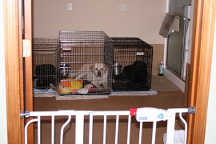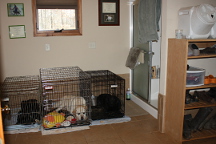

  |
Puppy Raising Tips & SuggestionsThese tips and suggestions are by no means a complete list. However, they do cover various areas and may be useful.
2. Once a litter is born, we place a pan or container with a towel soaked in a bleach and water mixture outside the front door in order that anyone coming into the house steps in the pan to prevent the passage of germs. 3. We continue with our usual routine around the house, just as one would with a new baby. That also means the litter is immediately exposed to noises such as the vacuum cleaner, radio and dishwasher. We also begin using the expression, ‘time to go to bed’ each night when the lights go out. 4. When introducing the puppies to solid food, we begin by lightly tapping the side of the feed dish with a spoon. Over the weeks, the pan will be hit harder. We have found that this operant conditioning strategy helps prepare puppies for loud noises they may encounter into adulthood. This introduction is not only advantageous to us as gun dog trainers, but also to the average new puppy owner for when they may be exposed to cars backfiring, thunder or other loud noises. 5. Although the puppies eat 3 scheduled meals daily until the age of approximately 4 months, we recommend that the food and water not be given after 6:30 p.m. in order to assist in housebreaking. 6. Housebreaking strategies:
7. Remember that dogs are ‘den’ animals and enjoy the stability and closeness experienced in a crate. It is not a jail cell, but puppies should not be left in the crate for long periods of time. Also, traveling with your dog in a crate in the car is similar to having a seat belt on. It is a great safety feature. 8. If practical, another strategy which may be useful in helping the puppy sleep through the night is to place the crate directly beside a dryer in the laundry room. Run a load of laundry, for the warmth and rhythmic noise appears to help the puppy go to sleep. Thus, you’ve killed two birds with one stone. 9. If a puppy is going into a home with children, we hand out the AKC list which has suggestions for children handling puppies. We also spend time with the new puppy and child/children teaching appropriate interaction with the puppy. 10. A puppy needs time, reinforcement, praise and love. The puppy does not learn by ‘osmosis.’ One skill that we teach new families is the ‘wait’, ‘stay’ and ‘o.k.’ command. A seven or eight week old puppy can quickly learn this command if done consistently. We have the owner move a kibble of food or treat slowly above the puppy’s head while holding the collar; thus dropping the back into a sitting position. That is the sit position. While sitting, the command ‘wait’ is given while the owner lightly holds the collar. After the owner counts to 3, the puppy is released on the ‘o.k.’ signal (stated in an upbeat and happy tone.) The puppy is then allowed to eat his food. This same command is given each time the puppy is fed; thus being reinforced positively at least three times a day. It is also given at the door before the puppy is taken out for his walk, before entering any door (such as the Vet’s office) and each time the puppy reaches the curb of a street while being walked. This skill has been proven to be a life-saving technique. 11. If the owner plans on showing in the future, we recommend teaching the obedience flat hand signal ( palm of hand down) for the stand position. Thus, the dog can learn the sit command described above, but understand the difference when showing in the ring. The ability to comprehend the difference in various skills can be compared to a horse which has been trained to perform in a variety of situations. For instance, a Morgan horse may be competing in pleasure riding, jumping and carting. The horse understands the difference in the bit, equipment and mannerisms of the rider. A puppy can learn the difference of various collars and the expectations of performing in multiple settings.
|
|
   | |